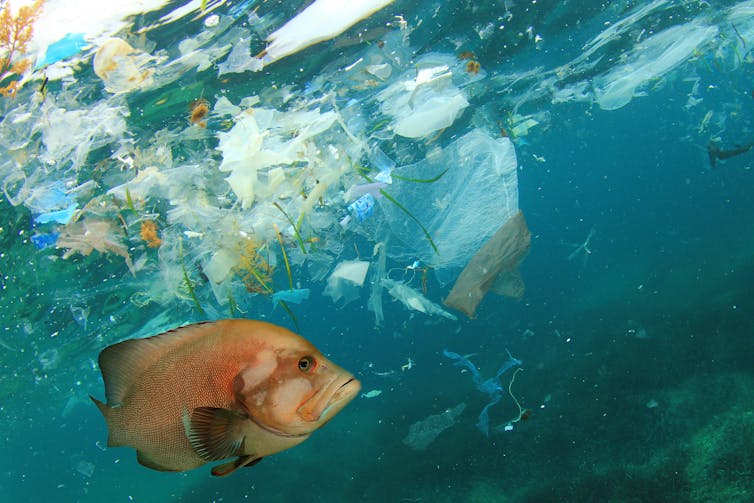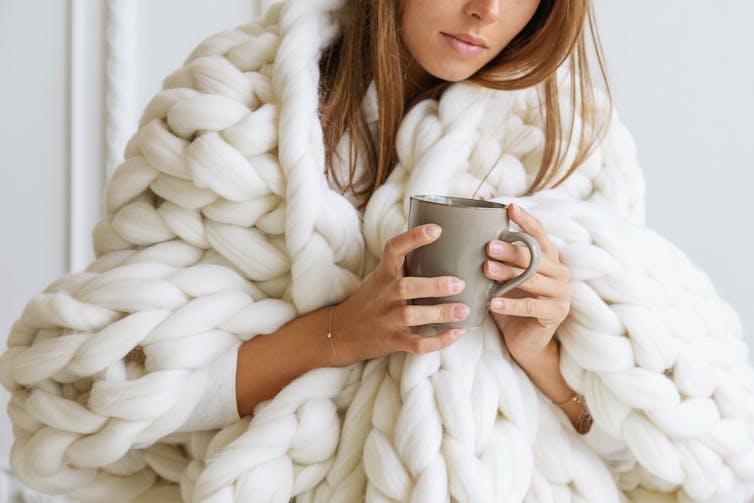hooded blankets are cosy but they are not great for oceans or our health
- Written by Vincent H.S. Yap, University of Tasmania
Last year, Australian kids hounded parents for Ooshies — character-based plastic collectibles distributed by supermarket chain Woolworths. But like the attention span of a five year old, the contentious marketing campaign quickly faded. This year, the similarly named Oodies are gaining viral attention — and presenting their own plastic problem.
The Oodie is essentially a wearable blanket comprising an oversized hooded sweatshirt and an equally oversized kangaroo pocket. Lined with light, ultra-soft and heat-retentive fabrics, Oodies are billed as the ultimate comfort-wear for those wanting to snuggle down in front of the TV — especially during a winter lockdown.
But what makes Oodies (and other hooded blanket brands) soft and warm is a wool-like material called fleece. While it can sometimes be made of cotton or acrylic, fleece is most often made of polyester. This synthetic fibre commonly derived from polyethylene terephthalate (PET) — the same plastic used to make water bottles — makes Oodies bad news for oceans.
Read more: Time to make fast fashion a problem for its makers, not charities
We know plastics are bad
Environmental concerns about Oodies extend beyond the amount of water such bulky items require to wash them. As most PET plastics still originate from fossil fuels, concern regarding the environmental impact of polyester-based garments is justified.
Not only does its production contribute to enhanced carbon emissions and global warming, synthetic fibres like polyester and acrylic are the dominant form of microplastic pollution in marine (and freshwater) environments. The main pollution source is microplastic fibres released from the washing of synthetic fabrics. Fleece-type garments (including Oodies) are likely major culprits.
Numerous studies have documented the detrimental effects of microplastic ingestion on various aquatic organisms (such as fish, mussels and crustaceans), ranging from impaired physiology to lowered reproduction and survival. According to marine biologists at the Plymouth Marine Laboratory, these effects may transfer up the food chain to reach humans.
Studies have also shown potential direct impacts of prolonged exposure to polyester microfibres on humans, including allergies, lung inflammation, disrupted hormonal function and even carcinogenic effects. This is allegedly due to harmful chemical additives (such as phthalates) that are commonly used in the manufacture of synthetic fabrics.
 Polyester fabrics can shed microplastics during washing that end up in the ocean. They might even wind up in fish we eat.
Shutterstock
Polyester fabrics can shed microplastics during washing that end up in the ocean. They might even wind up in fish we eat.
Shutterstock
Natural vs synthetic fibres
The apparel industry is working to become more sustainable, be it the fabrics used, or the manufacturing process involved. However, information about how and where Oodies are made is limited on their website. The garments are spruiked as vegan, which provides a positive spin.
Fleece can be made from cotton — some hooded blankets are of a flannel fleece exterior (made of cotton). This natural fibre — provided it’s been organically and sustainably farmed — is arguably more sustainable than polyester. It is a renewable resource that can biodegrade under favourable conditions.
However, polyester-made fleece remains the preferred fabric for most hooded blanket brands available (including the Oodie with its 100% polyester interior), presumably due to its relatively light weight, durability, better heat retention, moisture resistance and recyclability — and yes, polyester can be recycled!
Read more: Vegan leather made from mushrooms could mould the future of sustainable fashion
Is recycling (really) the answer then?
According to a 2017 study by the Swiss Federal Office for the Environment, production of recycled polyester uses 59% less energy than virgin polyester. It is also ostensibly less environmentally harmful than growing organic cotton, given the latter leaches nutrients from the soil and requires large open spaces to grow.
Of the hooded blankets brands we looked at (including the Oodie, Cotton On’s Snuggets, Bed Bath N, Table’s Hooded Sherpa and others) only BONDS’ Super Softies Reversible Hoodie indicates the use of recycled polyester. But that doesn’t necessarily make it a significantly “greener” choice. The relative proportion of the garment made of recycled polyester is not specified — it could be 90%, 50% or even 5%!
With any polyester-based fabric, recycled or not, the release of synthetic microfibres into wastewater systems and subsequently into natural waterways is inevitable.
Installing a decent microfibre filter in your laundry machine could help reduce the amount of microplastics entering the environment, but the efficiency of such filtering devices is still in need of urgent improvement.
Read more: Sustainable shopping: where to find a puffer jacket that doesn't warm the Earth
Some heroes wear capes … ones made of natural fibres!
Given we could not find fully cotton-based hooded blankets for sale, the current best alternative may well be to stick with standard, natural fibre-based blankets, throws or hoodies.
 Natural fibres, including wool, mean you can be cosy without synthetics.
Shutterstock
Natural fibres, including wool, mean you can be cosy without synthetics.
Shutterstock
These are typically made from organic cotton, hemp, Tencel or recycled wool and offered by eco-friendly brands like Bhumi and Seljak Brand.
As winter warmers, they are equally functional and do not generate microplastics. This makes them a much safer bet for the environment and health-wise.
Alternatively, you could sew your own hooded blanket. This would allow a choice of non-synthetic fabrics as well as personalised designs.
Sure, the Oodie is new and exciting with cute fabrics. But you get to wear conventional, non-synthetic blankets like a superhero cape and, quite literally, save the planet.
Authors: Vincent H.S. Yap, University of Tasmania



















